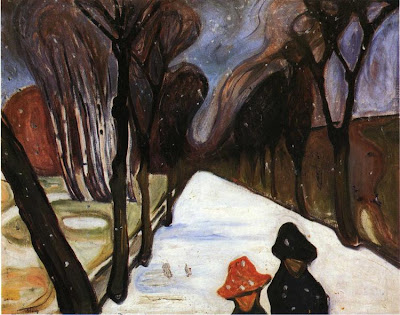Autumn is definitely creeping into the air and getting under
my skin, and when that happens you’ll find me in the galleries and museums of
our fair capital. I’ve had my eye on a few exhibitions recently, but the first
one of the new autumn season to actually draw me through the door was the
Edvard Munch: The Modern Eye show at Tate Modern.
 |
| Girls on the Bridge, 1927. Oil on Canvas. The Munch Museum, Oslo |
I’m not going to lie, I knew next to nothing about the chap
before I stepped through the door of the old power station. I knew
The Scream, which in my opinion, humble
as it never is, may be one of the most angst ridden and psychologically
troubling images ever created. There are four versions of
The Scream of Nature, which Munch created between 1893 an 1910, and
the inspiration behind the image gives a great introduction to the way Munch’s
mind worked…
One evening I was walking
along a path, the city was on one side and the fjord below. I felt tired and
ill. I stopped and looked out over the fjord—the sun was setting, and the
clouds turning blood red. I sensed a scream passing through nature; it seemed
to me that I heard the scream. I painted this picture, painted the clouds as
actual blood. The colour shrieked. This became The Scream.
 |
| The Scream, 1893. Oil, Tempera and Pastel on Cardboard. National Gallery, Oslo |
Well… Not a lot one can really say after that apart from
clearing ones throat and moving on to discussing the weather. Do not be put off
though, like an eccentric Uncle, Munch may throw the odd curve-ball into
conversation but he’s definitely not to be written off as raving. His history
help to explain a lot, so pay attention for a little History… Munch was born on
the 12th of December 1863 and grew up in Norway’s capital Christiania
(renamed Oslo). His mother died of tuberculosis in 1868, as did
Munch's favourite sister Sophie in 1877. After their mother's death, the
Munch siblings were raised by their father and by their aunt Karen. Often ill
for much of the winters and kept out of school, Edvard would draw to keep
himself occupied, and received tutoring from his school mates and his aunt. Christian’s
(Munch Senior) positive behaviour toward his children was overshadowed by his
morbid piety. Munch wrote, "My father was temperamentally nervous
and obsessively religious—to the point of psychoneurosis. From him I inherited
the seeds of madness. The angels of fear, sorrow, and death stood by my side
since the day I was born." As his artistic career progressed he began
to identify himself more and more with a bohemian circle of writers and artists
who rejected traditional value in art and life. Much of his time during three
years was spent in Paris and Berlin, living an often precarious existence, he
drew upon his anxieties and spiritual unrest. Unlike many expressionists who focused on the world around them, Munch took to recording his own emotional
and psychological states set against a backdrop of his native land.
 |
| Red Virginia Creeper, 1898-1900. Oil on Canvas. The Munch Museum. |
Given his somewhat precarious psychological state, it is
little wonder that Munch suffered a nervous breakdown in 1908 and he returned
to Norway to lead a more settled lifestyle, though still prone to the odd unconventional
outburst. He continued to record new ways of seeing, revealing a fascination
with photography and film, new movements in theatre and literature, and the
latest scientific breakthroughs. This was definitely one of the strongest and
most interesting parts of the exhibition; the link between science and the
psychological effect on society that these leaps forward had. Munch was
painting at a point in time when there was both a demystifying and a growing
curiosity and fascination with the unknown. Whilst there are many beautiful
images created by Munch during this period, my favourite (and interestingly my
+1’s as well) is the below. For me it typifies a human fascination with the
wider world, a step into the darkness with the hope of salvation and light in
the distance.
 |
| Starry Night, 1922-24. Oil on Canvas. The Munch Museum |
To say Munch was complicated would be like saying Caterham
cars are somewhat speedy (oh yes, my +1 is starting to rub off on me). The
thing that struck me the most in hindsight was his obsessiveness for repeating the
same image throughout his career, particularly the series of images Weeping Woman. There seems to be a compulsion
to capture the subjects state of mind, and the reaction of the artist to it.
Whilst there is no suggestion of frenzy or angst here, there is something
unsettling and emotionally uncomfortable about these paintings and the way the
figure is enclosed by the room and her own thoughts, occasionally bearing down
on her literally as well as metaphorically. Given this, they are still
beautiful images and remind me somewhat of Sarah Lederman’s paintings –
beautiful and inhabiting the world somewhere between darkness and light, and
self-reflection.
 |
| Weeping Woman, 1907. Oil and Crayon on Canvas. Munch Museum |
So, the season is underway, I hope you’re all prepared for
many more gallery trips and exhibition jabbering. Now, I’m off for a cuppa to
warm me up, brrrrrr…
 |
| Snow Falling In The Lane, 1906. Oil on Canvas. Munch Museum |






